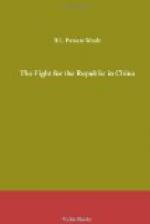In August, 1912, the British Minister in Peking presented a Memorandum to the Chinese Government outlining the attitude of Great Britain towards the Tibetan question. China was asked to refrain from dispatching a military expedition into Tibet, as the re-establishment of Chinese authority would, it is stated, constitute a violation of the Anglo-Chinese Treaty of 1906. Chinese suzerainty in regard to Tibet was recognized. But Great Britain could not consent to the assertion of Chinese sovereignty over a State enjoying independent treaty relations with her. In conclusion, China was invited to come to an agreement regarding Tibet on the lines indicated in the Memorandum, such agreement to be antecedent to Great Britain’s recognition of the Republic. Great Britain also imposed an embargo on the communications between China and Tibet via India.
In deference to the wishes of the British Government, China at once issued orders that the expeditionary force should not proceed beyond Giamda. In her reply she declared that the Chinese Government had no intention of converting Tibet into another province of China and that the preservation of the traditional system of Tibetan government was as much the desire of China as of Great Britain. The dispatch of troops into Tibet was, however, necessary for the fulfilment of the responsibilities attaching to China’s treaty obligations with Great Britain, which required her to preserve peace and order throughout that vast territory, but she did not contemplate the idea of stationing an unlimited number of soldiers in Tibet. China considered that the existing treaties defined the status of Tibet with sufficient clearness, and therefore there was no need to negotiate a new treaty. She expressed the regret that the Indian Government had placed an embargo on the communications between China and Tibet via India, as China was at peace with Great Britain and regretted that Great Britain should threaten to withhold recognition of the Republic, such recognition being of mutual advantage to both countries. Finally, the Chinese Government hoped that the British Government would reconsider its attitude.
THE SIMLA CONFERENCE
In May, 1913, the British Minister renewed his suggestion of the previous year that China should come to an agreement on the Tibetan question, and ultimately a Tripartite Conference was opened on October 13, at Simla with Mr. Ivan Chen, Sir Henry McMahon, and Lonchen Shatra as plemipotentiaries representing China, Great Britain, and Tibet, respectively.
The following is the substance of the Tibetan proposals:—
1. Tibet shall be an independent State, repudiating the Anglo-Chinese Convention of 1906.
2. The boundary of Tibet in regard to China includes that portion of Sinkiang south of Kuenlun Range and Altyn Tagh, the whole territory of Chinghai, the western portion of Kansuh and Szechuan, including Tachienlu, and the northwestern portion of Yunnan, including Atuntzu.




